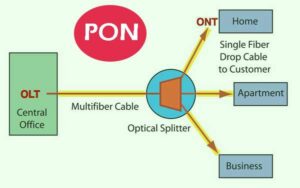XGS-PON is an fiber access network technology that supports symmetric 10Gbit/s transmission speeds. XG-PON and XGS-PON are both 10G PON, with the main difference being that XG-PON is an asymmetric PON with an upstream/downstream rate of 2.5G/10G at the PON port; XGS-PON is a symmetric PON, with an upstream/downstream rate of 10G/10G on the PON port.
XG-PON support sharing ODN (Optical Distribution Network) with GPON, and achieves mixed access of three types of ONU (Optical Network Unit) through Combo scheme, namely XGS-PON, XG-PON, and GPON. The implementation of this technology greatly enhances the multi service access capability of PON networks and is considered one of the important technologies for future access technologies to meet the needs of multi service fiber optic access networks.
Yingda rooted in optical passive network more than 15 years, and we take part in directly or indirectly more than 500+ projects, and have a thorough understanding of the optical communication development and market trends in various countries. Hope our experience can really help you, please contact us.




XGSPON network is symmetric 10 Gigabit passive optical network, both uplink and downlink transmission rate are the same 10Gbit/s.
GPON has a maximum downstream rate of close to 2.5 Gbps and an upstream rate of close to 1.25 Gbps, supporting non-tariff transmission. XGS-PON has a downstream and upstream rate of 10 Gbps, achieving ultimate transmission and higher transmission rates and bandwidth, making it more suitable for live broadcast and video surveillance. GPON is gradually being replaced by XG-PON and XGS-PON.
Yes, XGS-PON technology is suitable for gaming. XGS-PON technology has high bandwidth, low latency, and symmetrical upstream and downstream rates, which makes it very suitable for gaming applications.
yes, XGS-PON is backward compatible. XGS-PON can smoothly transition on the existing GPON network and achieve coexistence and compatibility with GPON.
XGS-PON is an extension of GPON based on the ITU-T G.987 standard, providing symmetric 9.953 Gbit/s transmission, especially suitable for high-bandwidth applications. It uses the same wavelength as GPON to achieve seamless coexistence. Specifically, the downstream wavelength of XGS-PON is 1577nm and the upstream wavelength is 1270nm.
Uplink and downlink both are 10G, the max. transmission rate is 9.953 Gbit/s.
The maximum splitting ratio of XGS-PON is 1:256, while max. split ratio 1:128 for GPON.However, in real cases, we will not use 1x128 or 1x256, because the more split light, the more likely to cause data packet loss.
The max transmission distance supported by the XGS-PON is 35 km, and the link loss is as high as 44 dB. These characteristics make XGS-PON perform well in long-distance transmission and high-loss environments.




Sorry that there’s no information that interests you. Please fill in the feedback form so that we can improve.